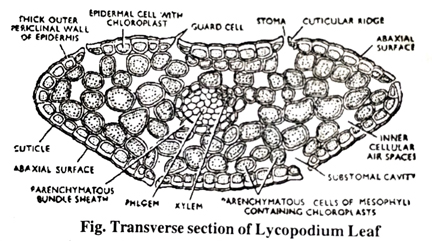Describe briefly the systematic position and salient features of morphology and anatomy of lycopodium. Add a brief note on its distribution.
Q. Describe briefly the systematic position and salient features of morphology and anatomy of lycopodium. Add a brief note on its distribution.
Ans. Systematic position:

Distribution and Habitat:
Lycopodium (the club moss) is world wide in its distribution and has nearly 180 sps. A majority of the species of Lycopodium are tropical, but certain of them are widely distributed in temperate regions. Most of the species of Lycopodium prefer moist situations and commonly grow in shady places rich in humus and other organic matter. The two sub-genera are recognised in Lycopodium (i) Subgenus Urostachya-In which branching always dichotomous and roots originate only from the base of stem. (ii) Subgenus Rhopalostachya-in which plant possessing prostrate stems bearing upright branches. Roots arise adventitiously all along the stem.
The common Indian species are:
1. Lycopodium cernuum,
2. Lycopodium clavatum.
3. Lycopodium serratum,
4. Lycopodium hamiltonii.
Morphology:
Lycopodium the so called clubmoss is a much branched herbaceous plant. The sporophytic plant body is differentiated into stem, leaves and roots. The stem is usually creeping rhizome which gives off slender elongated aerial branches from the upper side and adventitious root from the lower. The branches are densely covered with numerous small narrow pointed leaves. The leaves are simple and sessile, with a unbranched midrib in the centre and serrate margin. The stems in most species are much branched, with dichotomous or monopodial branching.

(A) Stem: A transverse section of the stem of Lycopodium shows a superficial epidermis, a broad cortex and a central massive vascular cylinder or ‘stele’.
The epidermis is a single outermost layer of small cell with the outer and often radial walls thickened and cutinized, it is provided with numerous stomata.
The cortex is a wide region lying between the epidermis and the stele. The relative thickness and structure of cortex varies from species to species. The cortex either may be homogeneous throughout and made up of parenchymatous cells or may be remain divided into three concentric zones, the outer cortex of simple parenchyma : middle cortex of sclerenchyma and inner cortex of parenchyma, as for e.g. in L. cernuum. In case of L. Clavatum, the outer and inner cortex is Sclerenchyma and middle one is parenchymatous. The endodermis marks off the stele from the cortical region, however, it is not well defined in all cases.
The stele is the central cylinder of the vascular system xylem and phloem, surrounded by a few layered, thin walled parenchyma, parenchyma comprising the pericycle. The stele of Lycopodium stem is protostele with a central xylem surrounded by phloem without any pith. But any how there is a good deal of variation in the arrangement of the vascular elements. There are commonly type of stele in different species of Lycopodium ;
(1) In some species like L. serratum and L. phlegmnaria xylem forms radiating arms form the centre, with alternating phloem this is called as actinostele.
(2) In other species like L. cernuum the xylem is broken up into isolated strands which is irregularly mixed with phloem this is called mixed Protostele.
(3) In other species as in L. Clavatum, L. complanatum, xylem and phloem occurs in alternating more or less parallel bands, this is called Plectostele.
In Lycopodium xylem is always exarch and consists of a few tracheids, and phloem consists of sieve tubes and phloem parenchyma. As the stele lacks cambium and hence there is no secondary growth.

Fig. Root of Lycopodium species as seen in transverse section
(B) Root: A transverse section of root is differentiated into a multilayered parenchymatous cortex surrounded by sclerenchymatous hypodermis and a thin walled epidermis. There are from seven to ten patches of protoxylem and corresponding metaxylem masses often unite in the centre presenting a stellate form with the phloem between the rays. Stele is surrounded by well defined endodermis.
(C) Leaf: A transverse section of leaf is differentiated into (1) Epidermiswhich is outermost layer of one cell thick and is highly cutirized interrupted by stomatas in the centre they remain surrounded by sclerenchymatous pericycle. In between the vascular bundle and stele the homogeneous parenchymatous mesophyll remain present which does not show any differentiation of tissues (Fig.)

Follow on Facebook page – Click Here
Google News join in – Click Here
Read More Asia News – Click Here
Read More Sports News – Click Here
Read More Crypto News – Click Here